14
Existing Projects and Platforms
14.1 Introduction
At the heart of body area network (BAN) architecture is the sensor platform equipped with a short- or even long-range communication capability. An on-board processing system is an extra but highly demanding and useful facility which is an emerging technology for smart sensors. The availability of smart sensors (remote system) further mobilises the research and technology for distributed and decentralised adaptive networks.
Several research groups and commercial vendors develop their own prototypes of wireless body sensor networks (WBSNs), also called wireless body area networks (WBANs) [1]. Some have more interest in building a system architecture and the associated service platform and others in developing the communication system focusing on the networking protocols, including routing algorithms. Here, a number of WBAN platforms are explained to give an overview of research and development as well as the market for developing body sensors, sensor networking, and communication strategies. Despite similarities, what makes them different are the short-range communication type, number of hops between the sensors and the sink, and of course the particular applications they focus on. These applications require particular body sensors as well as data acquisition and processing systems. On the other hand, the locations of sensors and sinks may be considered fixed or ad hoc and the overall system may include a diverse range of sensors. All these impose more complexity on the system design. In all these projects there are always the problem of energy constraint which has to be addressed and suitable solutions introduced.
The network developers should have solutions to the security and quality of service (QoS) problems, as discussed in Chapter 13. All these solutions somehow comply with IEEE 802.15.6 standard meant for WBAN [2]. However, the network topologies for BAN can be different. The most common ones are peer-to-peer, star, mesh, and clustered. Peer-to-peer topology doesn't rely on any coordinator station, though a pure peer-to-peer BAN topology hardly exists. Star topology is the most common BAN topology in which the coordinator acts as the star centre. Cluster topology is an extension of mesh topology where a number of meshes may interact through gateways. Similar to a mesh structure, a cluster topology allows more flexible communication infrastructures to interact with each other. Collaborative BANs and BAN–WSN interactive networks are two complex network infrastructures which may involve mesh or cluster topologies. Schematic diagrams of different popular topologies are presented in Figure 14.1.
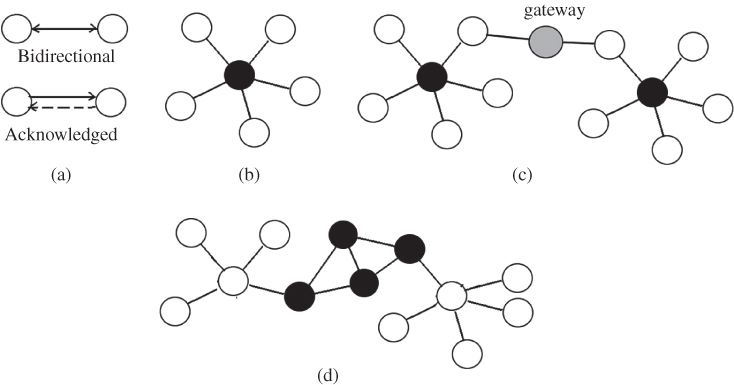
Figure 14.1 Popular network topologies: (a) peer-to-peer; (b) star topology where the black circle is the central hub; (c) mesh topology; (d) clustered topology. The links without direction are assumed bidirectional.
Otto et al. [3] and Jovanov et al. [4] have proposed a system architecture which handles the communications both within and between the WBANs. The system also incorporates a medical server in a multitier telemedicine system. The communication between the sensors and the sink (central body-mounted or near-body hub) is single-hop, slotted, and uses ZigBee or Bluetooth. The slots are synchronised using beacons periodically sent by the sink. They use off-the-shelf wireless sensors to design a prototype WBAN such as the Tmote sky platform from Moteiv (www.moteiv.com), which is now named Sentilla (www.sentilla.com). The Tmote sky platform is also deployed in the CodeBlue project [5, 6], where WBANs are used in rapid disaster response scenarios. In this project, a wearable computer attached to the patient's wrist including a Tmote sky mote forms an ad hoc wireless network with a portable computer. A wireless two-lead electrocardiogram (ECG), a wireless pulse oximeter sensor, and a wireless electromyogram (EMG) have been developed, too. Ayushman [7] is a sensor-network-based medical monitoring infrastructure that can collect, query, and analyse patient health information in real-time.
A wireless system including ECG, gait monitoring, and environment monitoring sensors has been developed using the existing components with a Mica2 wireless transceiver. Further, the necessary software for consulting the data at a remote client has been developed. The Human++ project by IMEC-NL [8] was initiated with the aim of achieving highly miniaturised and autonomous sensor systems. These systems enable people to carry their personal BANs. In another project, an ambulatory EEG/ECG system with a transmitter working on 2.4 GHz has been developed. This system can run for approximately three months using two AA batteries. In order to obtain a longer autonomy, the project also investigates energy scavenging with thermoelectric generators (TEG). In 2006, a wireless pulse oximeter fully powered by the patient's body heat was introduced. Further, the project investigates other short-range wireless technologies such as ultrawideband (UWB) to make an ultra-low power transmitter. The European MobiHealth project [9] provides a complete end-to-end m-health platform for ambulant patient monitoring, deployed over UMTS (Universal Mobile Telecommunications Service) and GPRS (General Packet Radio Service) networks. The MobiHealth patient/user is equipped with different sensors that constantly monitor vital signals (e.g. blood pressure, heart rate, and ECG). The communication between sensors and the personalised device is Bluetooth or ZigBee based and is single-hop. The most important considerations in this design are security, reliability of communication resources, and the necessary QoS level.
The French project BANET (www.banet.fr) was established to provide a framework, models, and technologies for designing optimised wireless communication systems. Such systems facilitate the widest range of WBAN-based applications in consumer electronics, medical, and sport domains. Their focus has been on the study of WBAN propagation channel, MAC protocols, and the coexistence of WBANs and other wireless networks. The German BASUMA (Body Area System for Ubiquitous Multimedia Applications) project [10] aimed at developing a full platform for WBANs. For the communication module, a UWB frontend has been implemented and a MAC protocol based on IEEE 802.15.3 applied. This protocol also uses timeframes primarily divided into congestion free periods (with time slots) and those with possible traffics through carrier sense multiple access–collision avoidance (CSMA/CA) local area networking (LAN) protocol. A flexible and efficient WBAN solution suitable for a wide range of applications was developed in [11]. The main focus in this solution was on posture and activity recognition applications by means of practical implementation and on-the-field testing. The sensors are WiMoCA-nodes which are represented by tri-axial integrated micro-electro-mechanical systems (MEMS) accelerometers. The Flemish IBBT IM3-project (Interactive Mobile Medical Monitoring) focuses on the research and implementation of a wearable system for health monitoring (http://projects.ibbt.be/im3). Patient data are collected using a WBAN and analysed at the medical hub worn by the patient. If an event (e.g. heart rhythm problems) is detected, a signal is sent to a healthcare practitioner who can view and analyse the patient data remotely for diagnostic purposes.
14.2 Existing Wearable Devices
Variety of activity trackers and smartwatches with the promise of healthier living have hit store shelves over the last couple of years. These devices (e.g. Apple's smartwatch, Microsoft's band, Jawbone's wristband, or Fitbit's fitness band), along with the supporting software, can gather information like steps, sleep, heart rate, sun exposure, and calories. Most of these wearable tracking devices are attractive, easy to use, accessible, and comfortable. However, they may lack health and medical care grade data quality (DQ), which slows down their commercialisation for clinical use. Such shortcomings include accuracy, consistency, data security, and credibility [12]. Many wearable-device makers believe that user engagement is more important than accuracy [13]. Most of these devices are introduced and their applications explained in detail in other chapters of this book.
14.3 BAN Programming Framework
In a BAN platform, often a certain programming framework is selected which in the best and fastest way provides access to the BAN components (i.e. sensors, network, processing units, and finally visualisation blocks). These also include gateways and security issues.
Most of the BAN architectures are divided into three or four layers (also called tiers). In a three-tier architecture there are body sensors, mobile devices, and archival systems. In a four-tier BAN architecture, the forth tier represents the visualisation, processing, and diagnostic tools and bodies (such as doctors and nurses).
14.4 Commercial Sensor Node Hardware Platforms
A number of platforms for BANs have been on the market for the past decade and the number of suppliers is increasing rapidly. This clearly shows the rising demand and importance of such platforms for capturing and assessing various human biomarkers.
Among the characterising indicators of BANs, node lifetime is one of the key parameters for the selection of wireless sensor communication board called remote (or mote in brief). The technical specifications of the mote directly or indirectly affect the lifetime of a sensor node. This parameter becomes particularly important for ‘power-hungry’ nodes deployed in remote environment. Usage of controllers in the hardware module with less power consumption enhances the availability of residual energy in the node to a greater extent. Radio frequency (RF) modules with increased efficiency in transmitters and receivers are obviously considered a trade-off with the node lifetime. Less-power-consuming processors, high-quality power supplies, and suitable (low) sampling frequency with lower computational cost are the favourable characteristics of BANs [14].
For example, TelosB uses an MSP430 processor, which supports five power-down states. An auxiliary module within TelosB supports power-down and sleep modes. It also enables the cutting-off of the RF module connection and the processing element. This reduces the battery drain, thereby increasing node lifetime. A number of wireless motes are described and, depending on their application usage, technical specifications, etc., classified in the following sections. The older motes are described first and the recent ones later.
14.4.1 Mica2/MicaZ Motes
The boards for early motes Mica2 and MicaZ are shown in Figure 14.2. In some applications the motes are combined with or connected to the sensor boards. These motes belong to the second- and third-generation mote technologies from CrossBow Technology. Mica2 and MicaZ use an Atmega128L controller along with a CC1000/CC2420 RF module, respectively. Mica2/MicaZ are equipped with humidity, temperature, and light sensors. These sensors are connected to the mote via an interface. These motes are capable of measuring barometric pressure, acceleration/seismic activity, and some other variables. The motes are powered by two external AA batteries within an operating range of 2.1–3.6 V DC. ZigBee is usually used as the short-range communication network for these motes.
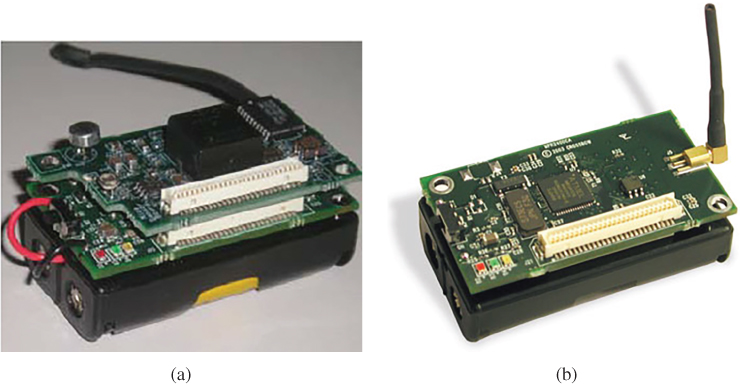
Figure 14.2 (a) Mica2 mote with its sensor board; (b) MicaZ mote.
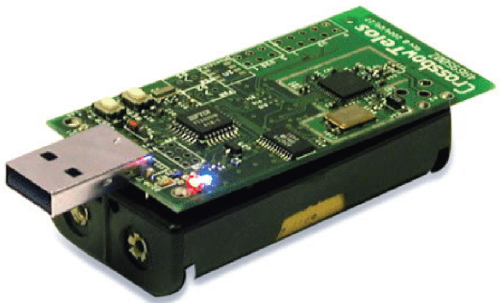
Figure 14.3 TelosB mote.
14.4.2 TelosB Mote
TelosB mote is shown in Figure 14.3. It was initially developed by the University of California, Berkeley. This mote embeds an 802.15.4-compatible CC2420 radio chip from Texas Instruments. It provides onboard humidity and temperature IC type sensors (SHT2x from Sensirion). The accuracy of relative humidity and temperature readings are, respectively, around 3% and 0.4 °C. The motes are powered by two external AA batteries with an operating range of 2.1–3.6 V DC. Additionally, XM1000 wireless motes have been designed according to TelosB specifications but with an upgraded program and data memory. In-built light sensors have also been introduced in this product.
14.4.3 Indriya-Zigbee Based Platform
Indriya is a capable hardware development environment for building ambient intelligence based wireless sensor network (WSN) applications [15]. It features a low-power MSP430 core with an IEEE 802.15.4-based CC2520 from Texas Instruments. On-board sensors include an accelerometer and light sensors together with many other optional add-ons. Indriya has many potential applications, including (a) indoor air quality management for which a humidity and/or a CO2 sensor can be added; (b) range measurement, direction finding, and tracking, for which an ultrasonic or a magnetometer can be interfaced; (c) image sensors can be integrated for security and surveillance; (d) occupancy detection and human occupancy-based controls with the help of a passive infrared sensor (PIR) interface. The RF module offers achievable data rates of 250 Kbps. The indoor and outdoor ranges of this mote vary, respectively, between 20–30 m and 75–100 m [16].
14.4.4 IRIS
An IRIS mote is shown in Figure 14.4. It is one of the available wireless node platforms which offer a higher communication range – close to 500 m in line-of-sight (LOS). It uses a 2.4 GHz IEEE 802.15.4 wireless module. The mote operates using a TinyOS operating system on an ATmega1281 based low-power micro-controller. The IRIS mote supports integrating sensor boards through a standard 51-pin expansion connector. It consumes 10–17 mA current in the transmitter and up to 16 mA in the receiver. The communication range varies above 300 and more than 50 m, respectively, for outdoor and indoor ranges (for LOS) [17]. Owing to its higher communication range, the motes can be deployed underground for agriculture and soil monitoring. Although soil provides higher interference to RF communication, it is possible to implement a network of underground motes within a mote-mote communication range of approximately 30 m underground. Moreover, IRIS motes can be integrated with a MIB600 TCP/IP Ethernet network, which can perform as a base station.
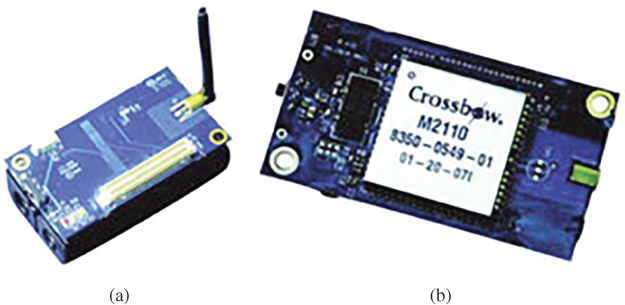
Figure 14.4 IRIS Mote: (a) top and (b) back views.
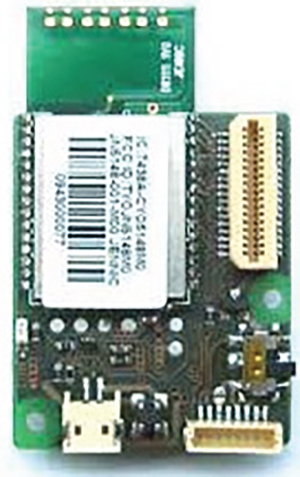
Figure 14.5 iSense core.
14.4.5 iSense Core Wireless Module
An iSense core module (Figure 14.5) combines the controller with an RF transceiver in a single housing. The microcontroller runs on a powerful 32-bit RISC core with a shared 128 Kbyte program and data memory. It is possible to reach the data rates as high as 667 kbps. The RF module facilitates a receiver sensitivity of −95 dBm and a transmit power of +2.5 dBm. An extra power module can also be added to increase the receiver sensitivity to −98 dBm and a transmit power level of +10 dBm (www.coalesenses.com).
14.4.6 Preon32 Wireless Module
A Preon32 Sensor node, depicted in Figure 14.6, is a universally applicable sensor and actuator platform for realisation of sophisticated implementations within short-range wireless networks. With a high-performance Cortex-M3 controller, it has an IEEE 802.15.4-compliant RF module. As a major advantage of this mote, the developers benefit from object-oriented languages like Java to program the wireless module. It also facilitates connection to external interfaces like CAN (controller area network), USB (universal serial bus), and SPI (serial peripheral interface) (www.virtenio.com). There are many applications for Preon32, including home automation, agricultural, habitat, and road traffic monitoring.

Figure 14.6 Preon32 wireless module.
14.4.7 Wasp Mote
Wireless sensing has become a demanding entity to attain a ‘smart environment’. One of the prevalent examples for this is a ‘smart water sensor’ utilising a Wasp mote (Figure 14.7), introduced by Libelium. A smartwater wireless sensing platform has been deployed to simplify the monitoring of water quality. The module enables measuring certain water quality parameters like PH levels, conductivity, dissolved ion content, and oxygen level. The nodes can be connected to the Internet or a cloud network for real-time monitoring and control. This platform uses an ultra-low-power sensor node for use in rugged environments. The sensor network connection can be via long range 802.15.4/ZigBee (868/900 MHz). Most importantly, this smartwater sensor can accommodate energy harvesting using solar panels.
14.4.8 WiSense Mote
An interesting platform for WSN and Internet-of-things (IoT) implementation is the WiSense platform illustrated in Figure 14.8. Apart from providing hardware modules for developers, WiSense provides a framework through which researchers and developers can build their own networks through a graphic user interface. The software makes use of an easy-to-use Eclipse platform involving an IEEE 802.15.4 protocol stack implementation. This system provides an extended support to the developer through hardware and software interfaces. The hardware platform involves an MSP430 low-power controller from Texas Instruments. The mote uses an 8/16 MHz clock together with a CC1101 RF module. With the usage of CC1101, possible applications of this mote extend to home automation, automated food ordering system in restaurants, campus network, industrial automation, green cities, and a variety of other home, industrial, and clinical applications. The data and program memory are set to 4 and 56 kB, respectively (www.wisense.in).
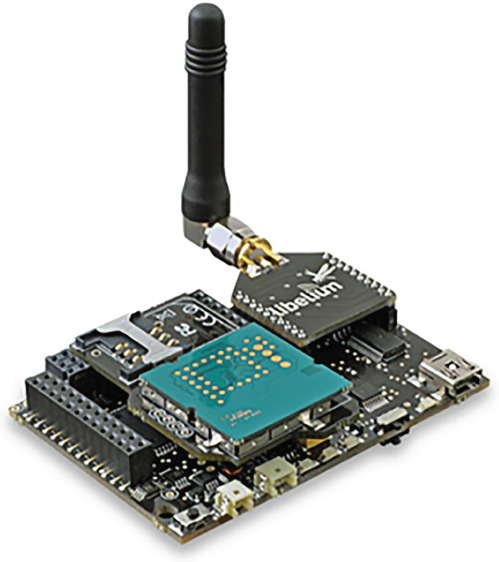
Figure 14.7 Wasp mote.

Figure 14.8 WiSense mote.
14.4.9 panStamp NRG Mote
The panStamp NRG relies on a CC430F5137 processor and an in-built CC11xx RF module. The main advantage of this module is that it needs much less space compared to the other available motes. It offers a programable speed of 8–24 MHz with flash and RAM capability of 32 and 4 kB, respectively. With the inclusion of a three-axis accelerometer and support for AES security encryption, this mote outperforms the standard available motes in the market. There are also options provided for including a dual temperature/humidity sensor at the bottom layer. Since the bottom layer is used for linking to optional sensors, it makes the sensing more efficient by reducing the effect of dust and other environmental parameters on the sensed values. Most importantly, panStamp allows the developers to integrate the mote with Raspberry Pi as a shield, making it the most supportive mote available (www.panstamp.com). The panStamp NRG 3 mote, shown in Figure 14.9, is a very recent version of the panStamp mote.
Collaborative BSNs which can combine or enable interaction between two or more BANs become important in order to monitor, recognise, or model group activities with the same goals.
Recently, integration of BANs and WSNs have become of great interest to healthcare system developers. This is particularly important since the mutual effects of the body and the environment in the case of, for example, a patient walking in or through air polluted regions, needs to be assessed or the pollution problems mitigated.
In this regard, some platforms which properly integrate multiple systems as well, as archiving resources such as the cloud, have emerged. Such platforms are mostly software-based and use the available hardware motes and modules to enhance their applications. Below, one of these platforms is addressed.
14.4.10 Jennic JN5139
This is a popular microcontroller often used at the sensor node [18]. The JN5139-Z01-M00R1T is a low-cost 2.4 GHz ZigBee mote with integrated antenna. It is a member of the JN5139-xxx-Myy IEEE802.15.4/ZigBee module range and is a surface-mount module that enables users to implement systems using a JenNet networking stack with minimum time to market. Using this mote, the lengthy development of custom RF board designs and test suites are avoided. JN5139 wireless microcontroller has been deployed to provide a comprehensive solution with high radio performance. Using this microcontroller, all that is required to develop and manufacture wireless control or sensing products is to connect a power supply and peripherals such as switches, actuators, and sensors which simplifies the product development. The JN5139 uses hardware MAC and highly secure advanced encryption standard ASE accelerators for low power and minimum processor overhead. A reasonably low power consumption is enabled using an integrated sleep oscillator and the necessary power saving facilities. The JN5139 module can be seen in Figure 14.10.

Figure 14.9 panStamp NRG 3 mote.
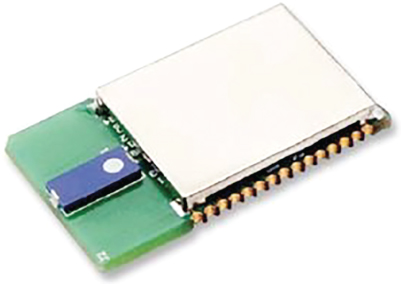
Figure 14.10 Jennic JN5139-Z01.
14.5 BAN Software Platforms
In order to power up the potentials and applications of the hardware and integrated modules powerful software including graphic user interfaces are needed. The approaches to achieve this goal can be either application- or platform-specific programming meant for particular applications, automatic code generation aiming at more generally applicable platforms, and middleware-based programming which allows for ease of and speedy access for the developers [19]. The main current software frameworks involved in BAN development are discussed below.
14.5.1 Titan
‘Titan’ stands for tiny task network [20] and is conceived to enable dynamic context recognition on the BAN. It provides the users/developers with a library of predefined tasks, each representing a particular operation such as a sensor reading, a processing function, or a classification algorithm. It is often represented as an interconnected graph representing a task execution over different blocks.
14.5.2 CodeBlue
This is a sensor network structure used as a decision support system [21] which supports medical assistive technology for both indoor and outdoor patient care applications. It uses TelosB and MicaZ as the base for BAN communication, processing, and security applications. CodeBlue is also based on a flexible publish/subscribe data delivery model providing a scalable and robust coordination.
14.5.3 RehabSPOT
It is another BAN platform [22] based on Sun SPOT sensor nodes developed for assisting physical therapists and patient limb rehabilitation treatment (www.sunspotdev.org). It allows for adaptive data collection, online processing, and display. It uses a centralised start-topology-based mesh to connect the sensors to a coordinator.
14.5.4 SPINE and SPINE2
SPINE is an open-source software for BAN [23, 24] and allows for programming over some popular hardware platforms such as TinyOS, Tmote Sky/TelosB, MicaZ, and Shimmer (www.shimmersensing.com). It also allows for ZigBee short-rang communication devices as well as Sun SPOT sensors.
Evolving from SPINE, SPINE2 is a task-oriented platform-independent programming framework [25, 26]. Following a layering approach, this allows an easier and faster adaptation of this system to the C-like sensor platforms.
14.5.5 C-SPINE
This has been designed to enable and support distributed or collaborative body sensor (or area) networks (CBANs) [27, 28]. The C-SPINE architecture includes the SPINE sensor-side and base station-side software components, with the addition of particular CBAN modules enabling wider applications including inter-CBAN communication, BAN proximity detection, BAN service discovery or selection, and application-specific protocols and services.
14.5.6 MAPS
It is a Java-based framework [29, 30] which allows for agent-oriented programming over sensor networks. MAPS facilitates the necessary bases for agents, including messaging, agent creation, cloning, and migration as well as timer handling and easy access to sensor node resources.
14.5.7 DexterNet
This BAN platform is open-source [31] and supports scalable and real-time monitoring for indoor and outdoor over heterogeneous wearable sensors. DexterNet includes three layers: body sensor, personal network, and global network layers.
14.6 Popular BAN Application Domains
Electronic health, games, entertainment, sport, emergency, social network, driving, and interacting with industrial systems are the most popular BAN applications. In Table 14.1 a summary of these BAN systems can be viewed.
Table 14.1 Popular BAN systems [19].
Source: Courtesy of Fortino, G., Gravina, R., and Galzarano, S.
| Design title | Application | Sensors | Hardware and accessories | Node platform | Communication protocol | Operating system/programming language |
| Real-time arousal monitor | Emotion recognition | ECG, respiration, temperature, GSR | Chest-belt, skin electrodes, wearable monitor, USB dongle | Custom | Wired sensor network | N/A, C-like |
| LifeGuard | Medical monitoring in space and extreme environments | ECG, blood pressure, respiration, temp., accelerometer, SpO2 | Custom microcontroller device, commercial biosensors | XPod signal conditioning unit | Bluetooth | N/A |
| Fitbit | Physical activity, sleep analysis, heart monitoring | Accelerometer, heart rate | Waist/wrist-worn device, PC USB dongle | Fitbit node | RF proprietary | N/A |
| VitalSense | Physical activity, heart monitoring, in- and on-body temperature | ECG, temperature, respiration, accelerometer | Wearable monitor, wireless sensors, skin electrodes, ingestible capsule | VitalSense monitor | RF proprietary | Windows mobile |
| LiveNet | Parkinson symptom, epilepsy seizure detection | Blood pressure, ECG, EMG, respiration, GSR, SpO2 temperature | PDA, microcontroller board | Custom physiological sensing board | Wires, 2.4GHz radio, GPRS | Linux (on PDA) |
| AMON | Cardiac and respiratory diseases | Blood pressure, ECG, accelerometer, SpO2, temperature | Wrist-worn device | Custom wrist-worn device | Sensors connected through wires-GSM/UMTS | C-like/JAVA (on the server station) |
| MyHeart | Prevention and detection of cardiovascular diseases | Blood pressure, ECG, EMG, respiration, GSR, SpO2 temperature | PDA, textile sensors, chest-belt | Proprietary monitoring station | Conductive yarns, Bluetooth, GSM | Windows on mobile/PDA |
| Human++ | General health monitoring | ECG, EEG, EMG | Low-power BAN nodes | ASIC | 2.4 GHz radio/UWB modulation | N/A |
| HealthGear | Sleep apnoea detection | Heart rate, SpO2 | Custom sensing board, commercial sensors, cell phones | Custom wearable station (including XPod unit) | Bluetooth | Windows on mobile |
| TeleMuse | Medical care and research | ECG, EMG, GSR | ZigBee wireless motes | Proprietary | IEEE 802.15.4/ZigBee | C-like |
| Polar heart rate monitor | Fitness and exercise | Heart rate altimeter | Wireless chest-belt, watch monitor | Proprietary watch monitor | Polar OwnCode (5 kHz) – coded transmission | N/A |
GSR: galvanic skin response; SpO2: blood oxygen saturation.
There are certainly many more application platforms developed on daily basis. Their description, however, is beyond the scope of this chapter.
14.7 Conclusions
To facilitate fast and easy BAN setup, good platforms (software and hardware) are necessary. Various WBAN platforms include sensors, processing, and communication modules. The networking strategies are limited but can accommodate various network topologies. The BAN hardware sensor and processing modules, however, have been under growing development and are well adapted to the new technology in electronics, sensing, data mining, archiving, and communications. The software platforms seem to be easier to expand. Their growth, however, requires the help of data processing and machine learning experts. In addition, the current platforms are mostly centralised. Even collaborative BANs, which include few relays, are not yet fully distributive. In future, decentralised systems are expected to exploit the capability of smart sensors to grow and allow more flexible, versatile, and user-specific BAN–BAN and BAN–WSN connections.
References
- 1 Latré, B., Braem, B., Moerman, I. et al. (2011). A survey on wireless body area networks. Wireless Networks 17 (1): 1–18.
- 2 IEEE Std 802.15.6-2012 (2012). IEEE standard for local and metropolitan area networks – Part 15.6: Wireless body area networks. New York: IEEE.
- 3 Otto, C., Milenkovic, A., Sanders, C., and Jovanov, E. (2006). System architecture of a wireless body area sensor network for ubiquitous health monitoring. Journal of Mobile Multimedia 1 (4): 307–326.
- 4 Jovanov, E., Milenkovic, A., Otto, C., and de Groen, P.C. (2005). A wireless body area network of intelligent motion sensors for computer assisted physical rehabilitation. Journal of Neuroengineering and Rehabilitation 2 (1): 16–23.
- 5 Gao, T., Greenspan, D., Welsh, M. et al. (2005). Vital signs monitoring and patient tracking over a wireless network. In: 27th IEEE International Conference of the in Engineering in Medicine and Biology Society, 102–105. Shanghai: EMBS.
- 6 Lorincz, K., Malan, D.J., Fulford-Jones, T.R.F. et al. (2004). Sensor networks for emergency response: challenges and opportunities. IEEE Pervasive Computing 3 (4): 16–23.
- 7 Venkatasubramanian, K., Deng, G., Mukherjee, T. et al. (2005). Ayushman: a wireless sensor network based health monitoring infrastructure and testbed. In: Distributed Computing in Sensor Systems, DCOSS, LNCS, vol. 3560 (eds. V.K. Prasanna, S.S. Iyengar, P.G. Spirakis and M. Welsh), 406–407. Berlin: Springer.
- 8 Gyselinckx, B., Vullers, R., Hoof, C.V. et al. (2006). Human++: emerging technology for body area networks. In: IFIP International Conference on Very Large Scale Integration, Nice, 175–180.
- 9 van Halteren, A., Bults, R., Wac, K. et al. (2004). Mobile patient monitoring: the mobihealth system. Journal on Information Technology in Healthcare 2 (5): 365–373.
- 10 Falck, T., Espina, J., Ebert, J.P., and Dietterle, D. (2006). BASUMA: the sixth sense for chronically ill patients. In: International Workshop on Wearable and Implantable Body Sensor Networks, BSN, Cambridge, MA, USA, 57–60.
- 11 Farella, E., Pieracci, A., Benini, L. et al. (2008). Interfacing human and computer with wireless body area sensor networks: the WiMoCA solution. Multimedia Tools and Applications 38 (3): 337–363.
- 12 Metz, R. (2015). The Struggle for Accurate Measurements on Your Wrist. MIT Technology Review http://www.technologyreview.com/review/538416/the-struggle-for-accurate-measurements-on-your-wrist.
- 13 Comstock, J. (2015) Fitness device makers say engagement, not accuracy, is most important. MobiHealth News (18 February). http://mobihealthnews.com/40646/fitness-device-makers-say-engagement-not-accuracy-is-most-important (accessed 14 December 2019).
- 14 Narayanan, R.P., Sarath, T.V., and Vineeth, V.V. (2016). Survey on motes used in wireless sensor networks: performance & parametric analysis. Wireless Sensor Network 8 (4): 67–76.
- 15 Rault, T., Bouabdallah, A., and Challal, Y. (2014). Energy efficiency in wireless sensor networks: a top-down survey. Computer Networks 67: 104–122.
- 16 Indrion (2020) Indriya_DP_01A11. www.indrion.co.in/datasheet/Indriya_DP_01A11.pdf (accessed 6 January 2020).
- 17 Crossbow Technology (2020) IRIS: Wireless measurement system. http://www.nr2.ufpr.br/∼adc/documentos/iris_datasheet.pdf (accessed 6 January 2020).
- 18 Fernandez-Lopez, H., Afonso, J.A., Correia, J.H., and Simoes, R. (2014). Remote patient monitoring based on ZigBee: lessons from a real-world deployment. Telemedicine Journal and E-Health 20 (1): 47–54.
- 19 Fortino, G., Gravina, R., and Galzarano, S. (2018). Wearable Computing from Modeling to Implementation of Wearable Systems Based on Body Sensor Networks. Wiley-IEEE Press.
- 20 Lombriser, C., Roggen, D., Stager, M., and Troster, G. (2007). Titan; a tiny task network for dynamically reconfigurable heterogeneous sensor networks. In: Kommunikation in Verteilten (KiVS), 127–138. New York: Springer.
- 21 Malan, D., Fulford-Jones, T., Walsh, M., and Moulton, S. (2004) CodeBlue: an ad hoc sensor network infrastructure for emergency medical care. Proceedings of the International Workshop on Wearable and Implementable Body Sensor Networks. https://dash.harvard.edu/bitstream/handle/1/3191012/1242078272-bsn.pdf?sequence=2 (accessed 14 December 2019).
- 22 Zhang, M. and Sawchuk, A. (2009). A customizable framework of body area sensor network for rehabilitation. In: Second International Symposium on Applied Science on Biomedical and Communication Technologies, (ISABEL). Bratislava, Slovak Republic (24–27 November 2009), 1–6. IEEE.
- 23 Fortino, G., Giannantonio, R., Gravina, R. et al. (2013). Enabling effective programming and flexible management of efficient body sensor network applications. IEEE Transactions on Human-Machine Systems 43 (1): 115–133.
- 24 Bellifemine, F., Fortino, G., Giannantonio, R. et al. (2011). SPINE: a domain-specific framework for rapid prototyping of WBSN applications. Software Practice and Experience 41 (3): 237–265.
- 25 Hui, J.W. and Culler, D. (2004). The dynamic behaviour of a data dissemination protocol for network programming at scale. In: Proceedings of 2nd International Conference on Embedded Networked Sensor Systems, 81–94. ACM.
- 26 Raveendranathan, N., Galzarano, S., Loseu, V. et al. (2012). From modeling to implementation of virtual sensors in body sensor networks. IEEE Sensors Journal 12 (3): 583–593.
- 27 Fortino, G., Galzarano, S., Gravina, R., and Li, W. (2015). A framework for collaborative computing and multi-sensor data fusion in body sensor networks. Information Fusion 22: 50–70.
- 28 Augimeri, A., Fortino, G., Galzarano, S., and Gravina, R. (2011). Collaborative body sensor networks. In: Proceedings of the IEEE International Conference on Systems, Man, and Cybernetics (SMC), 3427–3432. IEEE.
- 29 Aiello, F., Fortino, G., Gravina, R. et al. (2011). A Java-based agent platform for programming wireless sensor networks. The Computer Journal 54 (3): 439–454.
- 30 Aiello, F., Bellifemine, F., Fortino, G. et al. (2011). An agent-based signal processing in-node environment for real-time human activity monitoring based on wireless body sensor networks. Journal of Engineering Applications of Artificial Intelligence 24 (7): 1147–1161.
- 31 Kuryloski, P., Giani, A., Giannantonio, R. et al. (2009). DexterNet: An open platform for heterogeneous body sensor networks and its applications. In: Sixth International Workshop on Wearable and Implantable Body Sensor Networks, 92–97. IEEE.
